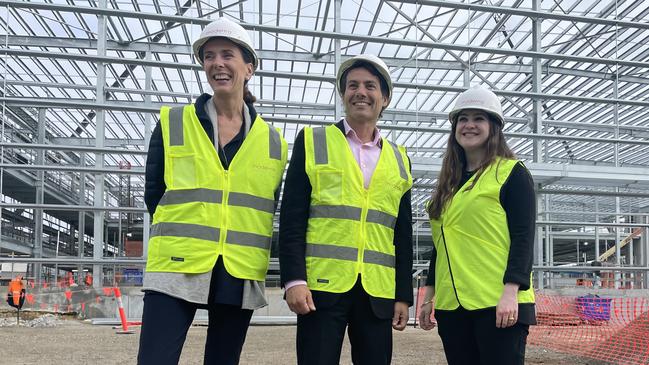Inside Moderna’s plan to make billions from its ‘superjab’, combining Covid-19 and flu vaccines in the one shot
The biotech giant says the world still needs a ‘superjab’, which will make it more convenient for people to be vaccinated against Covid-19 and influenza.

Business
Don't miss out on the headlines from Business. Followed categories will be added to My News.
A ‘superjab’ combining vaccines or Covid-19 and influenza in the one dose has achieved a similar or greater level of effectiveness than existing shots, biotech giant Moderna has revealed.
The Massachusetts-based company – which has signed a 10-year deal with the Australian government to produce respiratory vaccines in Melbourne – is advancing its so-called superjab to late stage trials after a successful phase1/2 study.
Its candidate vaccine, mRNA-1083, achieved an antibody response “similar to or greater” than existing quadrivalent influenza vaccines. Meanwhile, its performance against Covid-19 was similar to its Spikevax bivalent booster shot, which is currently available in Australia at vaccination centres and pharmacies.
Chief executive Stephane Bancel said flu and Covid-19 represent a “significant seasonal burden” on the health system and broader economy, underscoring the case for a superjab.
He also said the jab – which is anticipated to be available in Australia for the 2026 respiratory virus system, subject to regulatory approval – also was designed to encourage more people to be inoculated by making it more convenient.
“Combination vaccines offer an important opportunity to improve consumer and provider experience, increase compliance with public health recommendations, and deliver value for healthcare systems,” Mr Bancel said.
“We are excited to move combination respiratory vaccines into phase three development and look forward to partnering with public health officials to address the significant seasonal threat posed to people by these viruses.”
Australia will also play a key role in manufacturing the superjab. Moderna – which is listed on the Nasdaq with a market value of $US39.7bn ($62.7bn) – is halfway building a new factory in Melbourne, which is expected to begin operation by 2025.
The facility is part of a 10-year partnership with the Australian government to produce mRNA vaccines locally to prepare for the next pandemic (whatever its pathogen may be).
The Melbourne site will produce Moderna’s respiratory vaccines, including the superjab – possibly manufacturing the first vials for the 2025 northern hemisphere launch if all regulatory approvals are completed by then.

Moderna then expects respiratory product sales in 2027 to be in the range of $US8bn to $US15bn, with corresponding respiratory product operating profit in the range of $US4bn to $US9bn.
The superjab’s phase 1/2 clinical trial was a randomised, observer blind study evaluating the safety and immunogenicity of mRNA-1083 compared to a standard dose influenza vaccine, Fluarix, in adults 50–64 years of age and against an enhanced influenza vaccine, Fluzone HD, in adults 65–79 years of age.
For both age groups, mRNA-1083 was compared against Moderna’s Spikevax booster. The company said reported rates of solicited local and systemic adverse reactions after mRNA-1083 administration were similar to the standalone Covid-19 vaccine group in the trial.
“The majority of solicited adverse reactions were grade 1 or 2 in severity. Grade 3 solicited local or solicited systemic reactions were reported in less than 4 per cent of participants ages 50 and above. No new safety concerns were identified for mRNA-1083 compared to the standalone vaccines,” Moderna said in a statement.
The Company plans to begin a phase three trial of mRNA-1083 this year and is targeting potential regulatory approval for the combination vaccine in 2025 for use in the northern hemisphere respiratory virus season.
“Influenza epidemics occur seasonally and vary in severity each year, causing respiratory illnesses and placing a substantial burden on healthcare systems. Worldwide, influenza leads to 3-5 million cases of severe diseases and 290,000-650,000 influenza-related respiratory deaths annually, despite the availability of current influenza vaccines,” Moderna said.
“Influenza affects people of all ages, but older adults are disproportionately affected by influenza and its complications. The SARS-CoV-2 (Covid-19) virus remains a leading cause of severe illness and mortality throughout the world. Since the start of the pandemic in 2020, there have been approximately 770 million cases of Covid-19 respiratory illness and approximately seven million deaths reported globally.
“SARS-CoV-2 infects people of all ages, but higher rates of severe illness and death are observed among older individuals and individuals with pre-existing medical conditions.”
CSL – the biggest health company on the ASX with a market value of $120.9bn – is also eyeing a superjab. It has secured a licensing deal with Arcturus Therapeutics to access its late-stage amplifying mRNA vaccine platform technology, which includes a Covid-19 vaccine candidate.
But it believes its cell-based technology represents the next generation of influenza vaccines instead of the much hyped mRNA platform, which instructs the body to produce a protein to trigger an immune response against infection.
This week, CSL’s vaccine division, Seqirus, revealed that its cell-based influenza shot Flucelvax – which costs about $40 per dose – demonstrated between 10 – 15 per cent “relative improvement” in vaccine effectiveness compared to traditional egg-based vaccines among people aged 4–64 years. This was based on data from three influenza seasons in the United States from 2017-18.
More Coverage
Originally published as Inside Moderna’s plan to make billions from its ‘superjab’, combining Covid-19 and flu vaccines in the one shot





